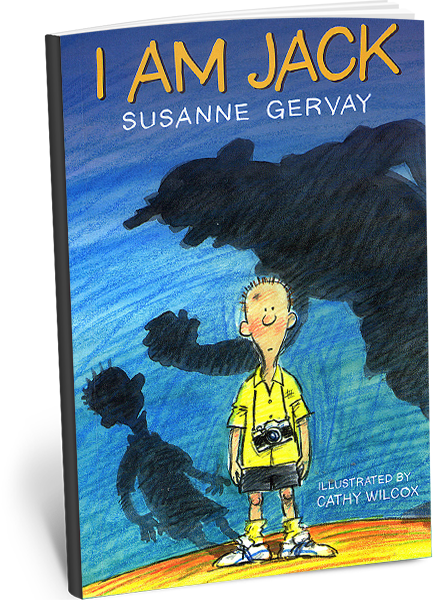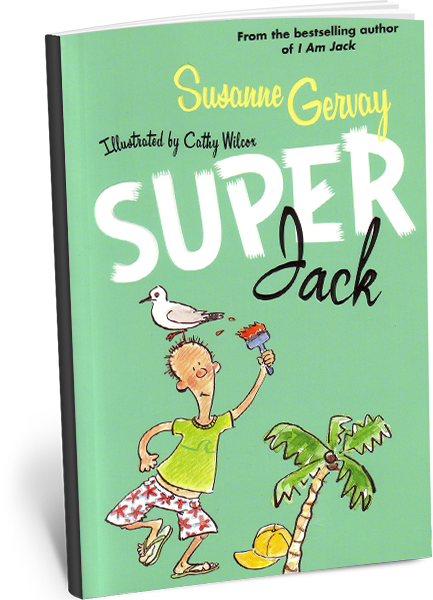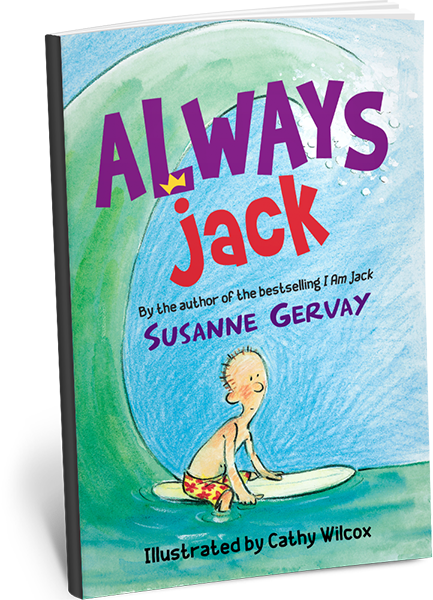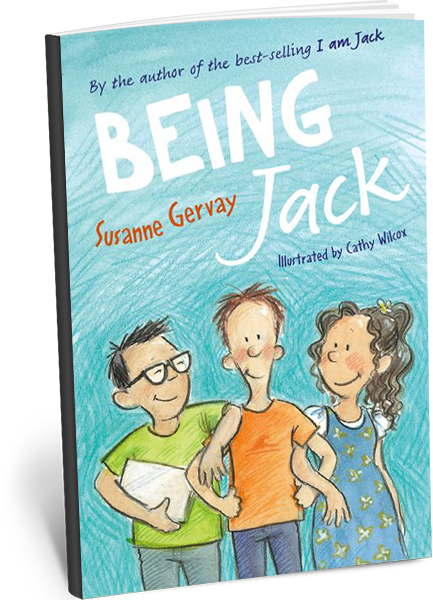Susanne Gervay’s I AM JACK series is a significant resource for parents, students and teachers. School bullying can have a devastating effect on a child and the school community. It can happen to anyone. Through story journey I AM JACK emotionally engages the bullied, bully, other children, teachers, parents exploring ways to create a safer place. The Alannah and Madeline Foundation.
What is bullying?




What do you consider “bullying” to be?
BULLYING IS NOT TEASING, CASUAL NAME CALLING, A HIT ON THE ARM, A BIT OF ROUGH AND TUMBLE be it in the school yard or on SMS.
Most kids experience and engage in some of this behaviour and still feel confident in who they are. Bullying is when teasing, punching, name calling isn’t funny anymore. When it’s used to intimidate and isolate another child. It’s when a bully with peer group support attacks the very basis of a child’s self esteem until a child is powerless, feeling there is no support from adults, the school and friends A child becomes a victim, develops low self esteem, depression and can show behaviours ranging from withdrawal, aggression, missing school and a feeling of no worth.
Read More About Bullying
What age is bullying a real concern?
Bullying occurs at all ages. However from around 7 years of age children become more involved in group behaviour. As parents gradually withdraw from the schoolyard, children are more unsupervised, and bullying becomes more prevalent. At this stage of development, children have neither the experience or emotional development to understand the impact of bullying on others or how to deal with bullying when they are targeted. Children especially need parental guidance at this stage.
Bullying is commonest between ages 9-15. Before 9, there tends to be parent presence and intervention. After 15, adolescents are developing their identity which includes understanding of their behaviour on others. However, the power of peer group behaviour after this age can have a devastating impact on a young adult who has endured long term bullying.
Are boys or girls bullied more? Are the ways in which they are bullied different? Is it worse for boys or girls?
Boys and girls are both bullied. Boys tend to be more obvious with physical actions while girls tend to use verbal and passive aggressive actions including SMS and technology. Both engage in isolating their victims. Cyber bullying has escalated the impact through broadening the peer group attack while camouflaging the perpetrator.
Girls who are bullied, can have an advantage in countering bullying when compared to boys. Girls’ verbal skills and communication skills mean they have chances to link into another group of girls. Boys tend to have less options.
Boys who are late physical developers tend to be more victimised than girls who are late developers. The common characteristics of children who are bullied are sensitivity and vulnerability. Importantly children who become isolated from the group through sickness, absences, starting school mid year and any event triggering isolation, become key targets.
Bullying is devastating for both boys and girls. However boys can have less resources to counter bullying as they cope with stereotypical expectations of male behaviour. There can be expectations that boys have to handle bullying by themselves because they are boys. Yet when bullying becomes entrenched no child can handle it alone. As boys get into their teens, they are less likely to speak to anyone about the bullying. Traditional ‘gossiping’ by girls, which is often condemned by society, in fact can act to make people aware of bullying and create support for the victim. However ‘gossiping’ can also have serious negative effects.
As a parent, what is the first thing you should do if you find out that your child is being bullied?
The first thing is to observe your child’s behaviours so you can identify key reactions to bullying including:-
- fall in school performances
- dropping out of activities
- friends not coming over
- developing headaches and similar
- trying to miss school
- getting into trouble at school
- change in activities
- changes in emotional behaviours such as anger, crying, silence
- spending a lot of time alone
Make special time for your child which is not a parent-child talk. Rather a natural activity where your child is comfortable. Go for a walk together or take your child out to a cafe – time when the parent is not preoccupied and the child feels special.
Give your child concrete positive experiences. For example if they like the movies, take them out just a parent and child or with the family or another child. Start to build experiences which enhance the child’s role as a valuable member of the family.
This is trust-time. It is a concrete way to show support, love and belief in your child.
Communicating will depend on the child’s personality, family interactions, the severity and longevity of the bullying. However each activity works towards rebuilding a child’s self esteem and trust, building strategies against bullying.
The communication must not artificial, confronting, the parent dictating the conversation.. It should be safe talking. Communication becomes more difficult if a child is seriously being bullied, as they are in personal crisis and usually afraid to speak. However continual positive experiences starts to break down the fear.
It’s important to assess the severity of the bullying when determining a course of action.
Acton can include:
- building friendships with other children through inviting them to events/ your home;
- getting into sport and similar;
- speaking to the teacher and/or principal;
- providing a parent presence in dangerous times such as before and after school;
- getting older sibling support.
There are many strategies. However the best is when the child is active in anti-bullying actions, with parental and school support. In this way, child moves away from a self image of powerless victim.
Do you think parents can “bully proof “their child? if so -how?
Parents can make bullying less likely to happen and also stop it escalating through:
- Supporting friendship groups with invitations to play for younger children
- Making the home available to teenage friends
- team activities from sports to drama groups to youth groups
- being aware of changes in your child’s behaviour and listening to issues before they escalate
- family and child-parent activities
- ensuring children have strong social networks
- discussing bullying with your child from all aspects including the bully, bullied, friends, bystanders, teachers, parents, school, the community.
- engaging in story journey so children emotionally understand bullying through books like Susanne Gervay’s I Am Jack and seeing performances such as MonkeyBaa Theatre’s adaptation of ‘I Am Jack’
- making NO TO BULLYING a parent concern that partners with the school in anti-bullying programmes.
Bullying is about isolating and then victimizing and destroys children’s belief in themselves.
However it is important to realize that bullies are not evil monsters. Many kids will bully at some time. Often bullying occurs because children do not understand the impact on the victim, they are having fun, they are in a group, peer group influence, feeling good about their own power, leading in the wrong way. There are many reasons a child bullies. It’s important that every child accepts responsibility for bullying – the bully, the bullied, the bystanders, friends.
To bully proof a child, everyone in the school community needs to be emotionally engaged and responsible for a NO BULLYING safe school environment.
What do you do if you find out that your child is the bully?
If your child is the bully, action depends on the severity of the bullying, the child’s personality and relationships in the family and similar factors.
There should already be conversations, books, parent-child chats during normal family activities that emotionally engage the child in the impact of their bullying others. Younger children are more responsive to being told not to bully another child. They are likely to apologise and follow parental guidance on establishing a non-bullying relationship with another child. However as they become teenagers, they are less likely to respond to a parent through being told. It is important to have a sense of fair play established BEFORE children go to high school.
If bullying of another child is severe, then the first priority is to ensure the bullied child is safe and the bullying must be stopped immediately. There can be punishments with withdrawal of privileges. However for your child to not be a bully, there needs to be an emotional understanding and belief by the child that bullying of others is wrong and there are also consequences for bullying behaviours on the bully.
Suggested actions:-
- Do not make excuses or joke or accept your child bullying another.
- Have a serious talk about the bullying and its impact on the victim
- NEGATIVE consequences for bullying such as withdrawal of privileges
- Work together to find resolutions
- Reward your child for POSITIVE actions such as apologising, inclusive behaviours, getting other kids who bully a child to stop
The real way to stop bullying escalating is through a school community approach where parents, teachers and children are all cooperative partners in creating a safe community.
Primary school is a time to reach children before they go to high school and face adolescence issues. Story journey is a powerful way to emotional engage primary school children so they feel the impact of bullying, recognize their own behaviours and determine how they want to act.
Relating to a story or being emotionally engaged facilitates learning. Readers become fellow travelers in a story journey. Lining, Phillips and Burton (1997) in a literature based approach to bullying rationalize that a story can allow the reader to empathize with situations that they may not have experienced, can provide the reader with reassurance that other people experience the same problems they do themselves, and can provide a situation where topics can be explored through a third party – the characters in the book. By taking students on a journey with Jack, attitudes, feelings and strategies about bullying can be explored and discussed in a non threatening way.”

I Am Jack
No bullying. No excuse. No reason. No way!
Strong people stand up for themselves. But the strongest stand up for others. (Plato)
I am Jack was written when my son was bullied at school. He’s a great kid, like all kids, except when they’re annoying of course!
After Jack won against school bullying (which was really hard), I asked him if it was all right to write I Am Jack.
‘Write it Mum. For other kids who get bullied, for kids who bully, for parents and teachers and everyone – so it doesn’t happen.’
I Am Jack is read by hundreds of thousands, of kids in Australia. It’s published in the USA, Turkey and lots of countries, even Slovenia. It’s even in Braille, so all kids can read I Am Jack and have Jack as a mate.
Endorsed by Room to Read, the Alannah & Madeline Foundation. Life Education Australia, Pacer anti bullying and many anti bullying organisations and programs.

Super Jack
Kids are Super Heroes
You’re braver than you believe, stronger than you seem, smarter than you think. (Christopher Robin).
Inspired by my family splitting, blending and changing, Super Jack is funny and emotional. Jack has a lot to deal with, but he’s a hero like all kids and navigates it all.
‘Divorce may be common but it is painful. Susanne Gervay writes humorously but with honesty about the rigours of living in a mix-master family.’ – The Weekend Age News, Review Section
Endorsed by Life Education, Australia
Super Jack is a stand-alone novel, and 2nd book in the I Am Jack series.

Always Jack
Dealing with the big issues
The important thing is to not stop questioning (Einstein)
‘Jack deals with big issues such as cancer, death, divorce, grandparents, sibling rivalry, friendships, refugees and the Vietnam War … Jack is Gervay’s vehicle for spreading words of wisdom … (you) empathise with Jack, love his sensitive introspection and his wisecracks …
Part survival manual, part therapy, part autobiography, part fiction, beautiful, sad, funny, Always Jackwill make you laugh and make you cry. Guaranteed. …Jack’s story will stay with readers always.’ – Sun-Herald Review
As a multiple breast cancer survivor, with two fantastic kids, I wrote Always Jack so kids always know they can question, find answers, share issues with family and friends and not be scared. Everything’ll be all right.
Endorsed by the Cancer Council, NSW.
Always Jack is a stand alone book, and 3rd book in the I Am Jack series.

Being Jack
Standing up to ALL Bullying. No Cyber Bullying. No way!
Knowing yourself is the beginning of all wisdom. (Aristotle)
Can’t believe that my Jack’s turning 13. But he has stuff to do before that. He wants to find his dad, even if his Dad might not want to see him. Jack has to decide to stand up for his mate against cyber bullying. He’s working out what’s right and wrong, and what sort of person he’s going to be.
“The I Am Jack books will continue to empower young people.” The Age. Susanne Gervay’s Being Jack hits back at bullies.
Launched and endorsed by Room to Read, bringing literacy to more than 12 million kids in Asia and Africa.
Being Jack is a stand alone novel and 4th in the I Am Jack books.
Monkey Baa’s I Am Jack
I Am Jack, the play, has been adapted by Eva Di Cesare, Sandra Eldridge and Tim McGarry, the artistic directors of Monkey Baa Theatre.
It has had eight outstanding tours across Australia from Sydney, the Outback to Perth. It has also had two successful tour across the USA from Las Vegas, Los Angeles to upstate New York.
The play performed to a packed audience as a fund raiser for Room to Read, celebrating the final book Being Jack n Darling Harbour, Sydney.
The Hon Michael Kirby says…
The Hon Michael Kirby says:- ‘We must all say No to Bullying and support ‘I Am Jack’. It is unacceptable. It is the desire to go back to the playground to attack difference. However difference is the great strength of community.’
The Hon Michael Kirby AC CMG is one of the greatest jurists of our time in Australia and internationally. He is the longest serving justice of the High Court of Australia, was Chair of the United Nations Human Rights Council’s Commission of Inquiry on Human Rights in the Democratic People’s Republic of Korea, served on the world stage for World Health Organisation on AIDS; United Nations commissions on bioethics and human rights. www.michaelkirby.com.au
